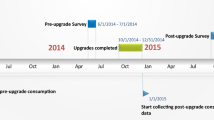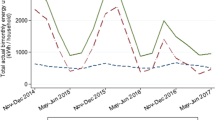Abstract
We examine the effect of energy efficiency incentives on household energy efficiency home improvements. Starting in February 2007, Italian homeowners have been able to avail themselves of tax credits on the purchase and installation costs of certain types of energy efficiency renovations. We examine two such renovations—door/window replacements and heating system replacements—using multi-year cross-section data from the Italian Consumer Expenditure Survey and focusing on a narrow period around the introduction of the tax credits. Our regressions control for dwelling and household characteristics and economy-wide factors likely to influence the replacement rates. The effects of the policy are different for the two types of renovations. With window replacements, the policy is generally associated with a 30 % or stronger increase in the renovation rates and number of renovations. In the simplest econometric models, the effect is not statistically significant, but the results get stronger when we allow for heterogeneous effects across the country. With heating system replacements, simpler models suggest that the tax credits policy had no effect whatsoever or that free riding was rampant, i.e., people are now accepting subsidies for replacements that they would have done anyway. Further examination suggests a strong degree of heterogeneity in the effects across warmer and colder parts of the country, and effects in the colder areas that are even more pronounced than those for window replacements. These results should, however, be interpreted with caution due to the low rates of renovations, which imply that the effects are estimated relatively imprecisely.



Similar content being viewed by others
Notes
The cost-effectiveness figures are somewhat more favorable when attention is restricted to the subset of utilities that report positive DSM expenditures in every year of the study.
Auffhammer et al. (2008) dispute these findings on definitions, metrics, and econometrics grounds.
DM 19/02/07 and subsequent laws. Currently ruled by DL 6/12/2011.
Caps of €30,000, €60,000, and €100,000 per residential unit apply, depending on the type of renovations.
Such surveys are available in other countries. For example, the Energy Information Agency within the US Department of Energy administers the Residential Energy Consumption Survey (see http://www.eia.gov/consumption/residential/). A similar study was conducted in Germany in 2005 (Grösche and Vance 2009) and information about dwellings, renovations, and energy use in the UK is gathered through the English Housing Survey (see https://www.gov.uk/government/uploads/system/uploads/attachment_data/file/88370/EHS_Headline_Report_2011-2012.pdf) and a variety of household surveys, including the British Household Panel Survey (see Meier and Rehdanz 2010) and the Continuous Household Survey (see Gans et al. 2013).
In Italy, a Region is a jurisdiction with authority similar to that of a US State, a Canadian Province, or a German Länder. There are a total of 20 Regions in Italy.
Renters do not constitute a legitimate control group. Their landlords are still entitled to the tax credits, provided that they meet the other requirements of the law, and at any rate the I-CEX questionnaire does not collect any information on home renovations from those households who rent their homes. Likewise, households living in multi-family housing or the homeowners association are eligible to receive the tax credits. One option might be to select renovations not covered by the tax credits and regard this type of renovations as the “control group.” Unfortunately, the Italian Consumer Expenditure Survey gathers data about home renovations using such broad definitions that it is impossible to identify an unambiguous “control” type of renovations.
An alternate specification that produces similar results simply enters a linear time trend in the right-hand side of Eq. (1) in lieu of the year dummies.
Depending on the year, 71–76 % of the households in the I-CEX own their home, mirroring nationwide homeownership rates.
For 2004–2006, the F statistic of the null that the coefficients on the year dummies are equal to zero is 1.65 (P value 0.2213) for window replacements and 0.83 (P value 0.4527) for heating system replacements. The F statistics are 2.05 and 3.82, respectively, for 2002–2006, with P values of 0.1320 and 0.0217. For 2001–2006, they are 1.70 and 2.24 (P values 0.1894 and 0.1081). A longer period (2000–2006) suggests that long-term trends are present (F statistics 6.07 and 8.13, respectively, with P values 0.0021 and 0.0003).
The F statistic of the null that the coefficients on all dwelling characteristics are jointly equal to zero is 13.96 (P value less than 0.0001) and that of the null that household characteristics do not matter is 57.23 (P value less than 0.0001). A similar test also concludes that HDDs and gas prices matter (F statistic 6.60, P value 0.0107), whereas unemployment and the conditions of the housing market are not important (F statistic 0.45, P value 0.6477).
This calculation uses the 2006 mean expenditure per window replacement (€2,106.59 on an annual basis, 2009 euro).
The results from similar estimation strategies for changing the heating system are similar and available from the authors.
References
Allaire, M., & Brown, S., (2012). “US energy subsidies: effects on energy markets and carbon emission,” prepared for the Pew Charitable Trusts, http://www.pewtrusts.org/uploadedFiles/wwwpewtrustsorg/Reports/Fiscal_and_Budget_Policy/EnergySubsidiesFINAL.pdf.
Allcott, H., & Greenstone, M. (2012). Is there an energy efficiency gap? Journal of Economic Perspectives, 26(1), 3–28.
Auffhammer, M., Blumstein, C., & Fowlie, M. (2008). Demand-side management and energy efficiency revisited. The Energy Journal, 29(3), 91–104.
Blumstein, C. (2010). Program evaluation and incentives for administrators of energy efficiency programs: can evaluation solve the principal/agent problem? Energy Policy, 38, 6232–6239.
Boomhower, J., & Davis, L. W. (2013). Free riders and the high cost of energy-efficiency subsidies. Berkeley: University of California. March.
Choi Granade, H. et al. (2009). Unlocking Energy Efficiency in the U.S. Economy, McKinsey Global Energy and Materials, available at http://www.mckinsey.com/en/Client_Service/Electric_Power_and_Natural_Gas/Latest_thinking/Unlocking_energy_efficiency_in_the_US_economy.aspx (last accessed 17 August 2011).
Dubin, J. A., & McFadden, D. (1984). An econometric analysis of residential electric appliance holdings and consumption. Econometrica, 52(2), 345–362.
ENEA (2008). Le detrazioni fiscali del 55 % per la riqualificazione energetica del patrimonio edilizio esistente nel 2007, Rome, Italy. http://efficienzaenergetica.acs.enea.it/doc/rapporto_2007.pdf.
ENEA (2009). Le detrazioni fiscali del 55 % per la riqualificazione energetica del patrimonio edilizio esistente nel 2008, Rome, Italy. http://efficienzaenergetica.acs.enea.it/doc/rapporto_2008.pdf.
ENEA (2010). Le detrazioni fiscali del 55 % per la riqualificazione energetica del patrimonio edilizio esistente nel 2009, Rome, Italy. http://efficienzaenergetica.acs.enea.it/doc/rapporto_2009.pdf.
Evans, W. N., & Schwab, R. (1995). Finishing high school and starting college: do catholic schools make a difference? Quarterly Journal of Economics, CX(4), 941–974.
Gans, W. L. (2012). The role of prices and information in residential energy consumption and investment behavior. PhD dissertation, University of Maryland, College Park, April.
Gans, W., Alberini, A., & Longo, A. (2013). Smart meter devices and the effect of feedback on residential electricity consumption: evidence from a natural experiment in Northern Ireland. Energy Economics, 36, 729–743.
Gillingham, K., & Palmer, K. (2013). “Bridging the energy efficiency gap,” Resources for the Future discussion paper 13-02, Washington, DC, January.
Golove, W. H., & Eto, J. H. (1996). Market barriers to energy efficiency: a critical reappraisal of the rationale for public policies to promote energy efficiency. Berkeley: Lawrence Berkeley Laboratory, UC Berkeley.
Grösche, P., & Vance, C. (2009). Willingness-to-pay for energy conservation and free-ridership on subsidization: evidence from Germany. The Energy Journal, 30, 141–160.
Grösche, P., Schmidt, C. M., & Vance, C. (2013). Identifying free-riding in home-renovation programs using revealed preference data. Journal of Economics and Statistics, 233, 600–618.
Haberl, H., Adensam, H., & Geissler, S. (1998). Optimal climate protection strategies for space heating: the case of Austria. Energy Policy, 26(15), 1125–1135.
Hartman, R. S. (1988). Self-selection bias in the evaluation of voluntary energy conservation programs. The Review of Economics and Statistics, 70(3), 448–458.
Hassett, K. A., & Metcalf, G. E. (1995). Energy tax credits and residential conservation investment: evidence from panel data. Journal of Public Economics, 57, 201–217.
Jaffe, A. B., & Stavins, R. N. (1994). The energy efficiency gap. What does it mean? Energy Policy, 22(10), 804–810.
Joskow, P. L., & Marron, D. B. (1992). What does a megawatt really cost? Evidence from utility conservation programs. The Energy Journal, 13, 41–73.
Kushler, M., Vine, E., & York, D. (2003). Using energy efficiency to help address electric systems reliability: an initial examination of 2001 experience. Energy, 28, 303–317.
Levine, M., Ürge-Vorsatz, D., Blok, K., Geng, L., Harvey, D., Lang, S., Levermore, G., Mehlwana, A. M., Mirasgedis, S., Novikova, A., Rilling, J., & Yoshino, H. (2007). “Residential and commercial buildings,” (pp 53–58) in Climate Change 2007.
Loughran, D. S., & Kulik, J. (2004). Demand-side management and energy efficiency in the United States. The Energy Journal, 25(1), 19–43.
Malm, E. (1996). An action-based estimate of the free-rider fraction in electric utility DSM programs. The Energy Journal, 25, 19–44.
Mansur, E., Mendelsohn, R., & Morrison, W. (2008). Climate change adaptation: a study of fuel choice and consumption in the US. Journal of Environmental Economics and Management, 55(2), 175–193.
Meier, H., & Rehdanz, K. (2010). Determinants of residential space heating expenditures in Great Britain. Energy Economics, 32, 949–959.
Moulton, B. R. (1990). An illustration of a pitfall in estimating the effect of aggregate variable on micro units. The Review of Economics and Statistics, 72, 334–338.
Shorrock, L. D. (1999). An analysis of the effect of government grants on the uptake of home insulation measures. Energy Policy, 27, 155–171.
Vine, E. (2003). Opportunities for promoting energy efficiency in buildings as an air quality compliance approach. Energy, 28, 319–341.
Vine, E., du Pont, P., & Waide, P. (2001). Evaluating the impact of appliance efficiency labeling programs and standards: process, impact, and market transformation evaluations. Energy, 26, 1041–1039.
Waldman, D. M., & Ozog, M. T. (1996). Natural and incentive-induced conservation in voluntary energy management programs. Southern Economic Journal, 62(4), 1054–1071.
Walsh, M. J. (1989). Energy tax credits and housing improvements. Energy Economics, 11(4), 275–284.
Wooldridge, J. M. (2010). Econometric analysis of cross section and panel data (2nd ed.). Cambridge: MIT Press.
Young, D. (2008). Who pays for the ‘beer fridge’? Evidence from Canada. Energy Policy, 36, 353–560.
Acknowledgments
The authors are very grateful to Francesco Bosello, Cristina Cattaneo, Roberta Distante, Massimo Filippini, and Elena Verdolini for helpful discussions. We are also grateful to the attendees of the 12th IEAEE congress in Venice, the 5th EMEE workshop in Berlin, and the CEPE seminar series at ETH Zurich, where this paper was presented, for their comments and suggestions. This research was funded by the European Union’s Seventh Framework Programme (FP7/2007–2013) under grant agreement No. 265325 (PURGE—Public health impacts in URban environments of Greenhouse gas Emissions reduction strategies).
Author information
Authors and Affiliations
Corresponding author
Appendices
Appendices
Appendix 1. Probit models
Appendix 2
Appendix 3
Rights and permissions
About this article
Cite this article
Alberini, A., Bigano, A. & Boeri, M. Looking for free riding: energy efficiency incentives and Italian homeowners. Energy Efficiency 7, 571–590 (2014). https://doi.org/10.1007/s12053-013-9241-7
Received:
Accepted:
Published:
Issue Date:
DOI: https://doi.org/10.1007/s12053-013-9241-7




